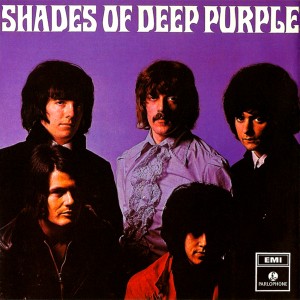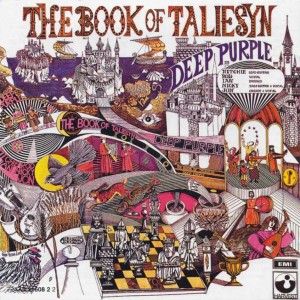Riffs, Rants & Rumors: Digging Into Deep Purple's Paisley Past
posted in: Features • Music News • Rock
 If you’re like 99.9% of the population, the words Deep Purple instantly evoke the quintessential classic-rock power-chord riff that drives Smoke On The Water. Secondarily, the stratospheric wail of Ian Gillan screeching out the chorus of Highway Star might leap to mind. Both are to ˜70s rock what the lion’s roar is to MGM, and they make it immediately clear why Deep Purple has always been revered as one of the bedrock bands whose hard-rock tonnage paved the way for heavy metal (In it’s day, it was considered heavy metal). Given this knowledge, you might feel confident in knowing all one needs to know about the band. You’d be wrong.
If you’re like 99.9% of the population, the words Deep Purple instantly evoke the quintessential classic-rock power-chord riff that drives Smoke On The Water. Secondarily, the stratospheric wail of Ian Gillan screeching out the chorus of Highway Star might leap to mind. Both are to ˜70s rock what the lion’s roar is to MGM, and they make it immediately clear why Deep Purple has always been revered as one of the bedrock bands whose hard-rock tonnage paved the way for heavy metal (In it’s day, it was considered heavy metal). Given this knowledge, you might feel confident in knowing all one needs to know about the band. You’d be wrong.
 Long ago and far away, back in the days of paisley and patchouli, there was another Deep Purple. Today it’s commonly referred to as the Mk. I version of the band. And while it included three-fifths of the classic ˜70s lineup, it was a different beast entirely. Keyboardist Jon Lord, guitar hero Ritchie Blackmore and drummer Ian Paice were all on board for the original incarnation of Purple, but instead of Gillan’s piercing wail, Deep Purple Mk. I boasted the low, soulful tones of Rod Evans, while Nick Simper occupied the bass chair rather than Roger Glover, and instead of chugging, chomping, hard-stomping proto-metal, they played a progressive-pointing brand of psychedelia.
Long ago and far away, back in the days of paisley and patchouli, there was another Deep Purple. Today it’s commonly referred to as the Mk. I version of the band. And while it included three-fifths of the classic ˜70s lineup, it was a different beast entirely. Keyboardist Jon Lord, guitar hero Ritchie Blackmore and drummer Ian Paice were all on board for the original incarnation of Purple, but instead of Gillan’s piercing wail, Deep Purple Mk. I boasted the low, soulful tones of Rod Evans, while Nick Simper occupied the bass chair rather than Roger Glover, and instead of chugging, chomping, hard-stomping proto-metal, they played a progressive-pointing brand of psychedelia.
In fact, the psychedelically inclined version of the band made no less than three albums between 1968 and ’69”Shades of Deep Purple, The Book of Taliesyn and a self-titled third outing. In the US, these releases have largely been swept under the rug, which is ironic, considering that ˜60s Purple’s greatest success by far was in America, where they scored three chart hits, most notably a churning cover of roots-rocker Joe South‘s Hush. In fact, more people probably know that song from the Deep Purple version than the original. Nevertheless, all three albums have been languishing in obscurity for years, remaining out of print and all but forgotten by the world at large. Thankfully, the balance of rock & roll history can be restored to its proper position at last, with the Eagle Records reissue of Deep Purple Mk. I’s entire output, expertly remastered and featuring a brace of bonus tracks.
 Trawling through the band’s psychedelia-soaked past, it becomes clear that, while they were very much in tune with their times, they were also on the leading edge of that particular portion of the UK psych scene that evolved into first-generation progressive rock. Like early Yes and a handful of others, they worshiped at the altar of prog-rock granddaddies Vanilla Fudge, the New York band whose 1967 debut was the first to take pop tunes of the day and elongate them into extended, drama-drenched suites. Shades of Deep Purple, like the first Yes album, is full of such psychedelically enhanced cover tunes; in addition to their hopped-up take on Hush, the lads tackle The Beatles‘ We Can Work It Out, the Hendrix hit Hey Joe and bluesman Skip James‘s I’m So Glad (previously covered on Cream‘s first album). Jon Lord was already going for baroque (sorry) with his organ excursions, and the classically-influenced exchanges between him and Blackmore seemed set solidly in the pre-prog mode even in 1968. At the same time, though, Evans injected a warm earthiness miles away from the lupine howl of his successor Gillan. Among the first-rate bonus cuts is a live version of Hush from the Hugh Hefner-hosted Playboy After Dark TV show, which is also well worth viewing on YouTube, as much for Hef’s guitar lesson from Blackmore and the sight of his mod-looking harem dancing to Deep Purple as for the song itself.
Trawling through the band’s psychedelia-soaked past, it becomes clear that, while they were very much in tune with their times, they were also on the leading edge of that particular portion of the UK psych scene that evolved into first-generation progressive rock. Like early Yes and a handful of others, they worshiped at the altar of prog-rock granddaddies Vanilla Fudge, the New York band whose 1967 debut was the first to take pop tunes of the day and elongate them into extended, drama-drenched suites. Shades of Deep Purple, like the first Yes album, is full of such psychedelically enhanced cover tunes; in addition to their hopped-up take on Hush, the lads tackle The Beatles‘ We Can Work It Out, the Hendrix hit Hey Joe and bluesman Skip James‘s I’m So Glad (previously covered on Cream‘s first album). Jon Lord was already going for baroque (sorry) with his organ excursions, and the classically-influenced exchanges between him and Blackmore seemed set solidly in the pre-prog mode even in 1968. At the same time, though, Evans injected a warm earthiness miles away from the lupine howl of his successor Gillan. Among the first-rate bonus cuts is a live version of Hush from the Hugh Hefner-hosted Playboy After Dark TV show, which is also well worth viewing on YouTube, as much for Hef’s guitar lesson from Blackmore and the sight of his mod-looking harem dancing to Deep Purple as for the song itself.
 The Book of Taliesyn (He was the bard of King Arthur’s court, in case you were wondering”gotta love the late ˜60s) was recorded a mere three months after its predecessor”they really churned ˜em out in those days ”and released in the fall of ’68, though the band’s also-ran status in their homeland was underlined by the fact that it didn’t get a British release until summer ’69. It too contained some tricked-out cover tunes, including Neil Diamond‘s Kentucky Woman and a truly epic take on Ike & Tina Turner‘s River Deep, Mountain High that exploited Evans’ full dramatic and dynamic range. Lord remained unreserved in his classical passions, attaching a Tchiakovsky-based intro onto a version of another Fab Four hit, Help. And the instrumental mastery of Blackmore really began to blossom as well, especially in his expressive solo on the understated, intense Shield.
The Book of Taliesyn (He was the bard of King Arthur’s court, in case you were wondering”gotta love the late ˜60s) was recorded a mere three months after its predecessor”they really churned ˜em out in those days ”and released in the fall of ’68, though the band’s also-ran status in their homeland was underlined by the fact that it didn’t get a British release until summer ’69. It too contained some tricked-out cover tunes, including Neil Diamond‘s Kentucky Woman and a truly epic take on Ike & Tina Turner‘s River Deep, Mountain High that exploited Evans’ full dramatic and dynamic range. Lord remained unreserved in his classical passions, attaching a Tchiakovsky-based intro onto a version of another Fab Four hit, Help. And the instrumental mastery of Blackmore really began to blossom as well, especially in his expressive solo on the understated, intense Shield.
The band’s eponymous 1969 release opens with a whirling, polyrhythmic Paice groove that seems like it’s begging to be sampled by some ambitious beatmeister. And while it finds the band honing previous ideas to a fine point, the wheels were already starting to come off by this time. Deep Purple’s label, Tetragrammaton, was floundering financially and about to go under. Lord and Blackmore, perhaps partly influenced by these dire straits and the band’s inability to catch fire in England, began dreaming of a new direction that didn’t involve Evans and Simper. It’s a shame, then, that the former is at his most affecting here, crooning a lambent take on Donovan‘s ballad Lalena, and the band’s prog-inclined leanings had reached a peak with the ambitious April, achieving a true blend of classical and rock. For the record (no pun intended), the cover art is a portion of Garden of Delights, the same Hieronymus Bosch triptych that adorns the front of US psych-folk outfit Pearls Before Swine‘s 1967 album One Nation Underground.
If things had gone just a bit differently, Purple Mk. I might have turned the corner and become a first-class prog-rock outfit along with contemporaries Yes, King Crimson and Genesis. But instead, Lord and Blackmore booted their singer and bassist, with Paice’s support, and brought aboard Gillan and Glover. Determined to take a harder, less ornamental approach, they soon crafted a heavy-hitting sound that eschewed both the subtleties and the expansiveness of their psychedelic period, pointing the way toward heavy metal, and becoming bona fide superstars in the process. History is written by the winners, which is why most of the world regards Mk. II as the ultimate Purple lineup, but Eagle’s reissue campaign is a vital reminder of the band’s less-celebrated, equally worthwhile beginnings.
